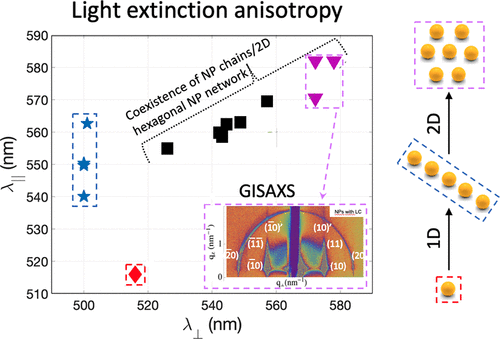当前位置:
X-MOL 学术
›
Nano Lett.
›
论文详情
Our official English website, www.x-mol.net, welcomes your feedback! (Note: you will need to create a separate account there.)
From Chains to Monolayers: Nanoparticle Assembly Driven by Smectic Topological Defects.
Nano Letters ( IF 10.8 ) Pub Date : 2020-01-17 , DOI: 10.1021/acs.nanolett.9b04347 Syou-P'heng Do 1 , Amine Missaoui 1 , Alessandro Coati 2 , Delphine Coursault 3 , Haifa Jeridi 1 , Andrea Resta 2 , Nicolas Goubet 1 , Michal M Wojcik 4 , Arnaud Choux 1 , Sébastien Royer 1 , Emrick Briand 1 , Bertrand Donnio 5 , Jean Louis Gallani 5 , Brigitte Pansu 6 , Emmanuel Lhuillier 1 , Yves Garreau 2, 7 , David Babonneau 8 , Michel Goldmann 1, 2 , Doru Constantin 6 , Bruno Gallas 1 , Bernard Croset 1 , Emmanuelle Lacaze 1
Nano Letters ( IF 10.8 ) Pub Date : 2020-01-17 , DOI: 10.1021/acs.nanolett.9b04347 Syou-P'heng Do 1 , Amine Missaoui 1 , Alessandro Coati 2 , Delphine Coursault 3 , Haifa Jeridi 1 , Andrea Resta 2 , Nicolas Goubet 1 , Michal M Wojcik 4 , Arnaud Choux 1 , Sébastien Royer 1 , Emrick Briand 1 , Bertrand Donnio 5 , Jean Louis Gallani 5 , Brigitte Pansu 6 , Emmanuel Lhuillier 1 , Yves Garreau 2, 7 , David Babonneau 8 , Michel Goldmann 1, 2 , Doru Constantin 6 , Bruno Gallas 1 , Bernard Croset 1 , Emmanuelle Lacaze 1
Affiliation

|
In this Letter, we show how advanced hierarchical structures of topological defects in the so-called smectic oily streaks can be used to sequentially transfer their geometrical features to gold nanospheres. We use two kinds of topological defects, 1D dislocations and 2D ribbon-like topological defects. The large trapping efficiency of the smectic dislocation cores not only surpasses that of the elastically distorted zones around the cores but also surpasses the one of the 2D ribbon-like topological defect. This enables the formation of a large number of aligned NP chains within the dislocation cores that can be quasi-fully filled without any significant aggregation outside of the cores. When the NP concentration is large enough to entirely fill the dislocation cores, the LC confinement varies from 1D to 2D. We demonstrate that the 2D topological defect cores induce a confinement that leads to planar hexagonal networks of NPs. We then draw the phase diagram driven by NP concentration, associated with the sequential confinements induced by these two kinds of topological defects. Owing to the excellent large-scale order of these defect cores, not only the NP chains but also the NP hexagonal networks can be oriented along the desired direction, suggesting a possible new route for the creation of either 1D or 2D highly anisotropic NP networks. In addition, these results open rich perspectives based on the possible creation of coexisting NP assemblies of different kinds, localized in different confining areas of a same smectic film that would thus interact thanks to their proximity but also would interact via the surrounding soft matter matrix.
中文翻译:

从链到单层:受近晶拓扑缺陷驱动的纳米粒子组装。
在这封信中,我们展示了如何使用所谓的近晶油性条纹中的拓扑缺陷的高级层次结构将其几何特征依次转移到金纳米球上。我们使用两种拓扑缺陷,一维位错和二维带状拓扑缺陷。近晶位错核心的大俘获效率不仅超过核心周围的弹性变形区域的捕获效率,而且还超过了二维带状拓扑缺陷之一。这使得能够在位错核中形成大量排列的NP链,这些核可以被准填充而在核外没有任何明显的聚集。当NP浓度足够大以完全填充位错核心时,LC限制范围从1D到2D。我们证明了二维拓扑缺陷核心诱导了一个限制,导致了NP的平面六边形网络。然后,我们绘制由NP浓度驱动的相图,该相图与这两种拓扑缺陷引起的顺序限制有关。由于这些缺陷核的出色的大规模订购,不仅NP链而且NP六角形网络都可以沿所需方向定向,这为创建1D或2D高度各向异性NP网络提供了一条可能的新途径。此外,这些结果基于可能共存的不同种类的NP组件的存在而开辟了广阔的前景,这些NP组件位于同一近晶薄膜的不同限制区域中,由于它们的接近性,它们将相互作用,但也会通过周围的软物质矩阵相互作用。
更新日期:2020-02-11
中文翻译:

从链到单层:受近晶拓扑缺陷驱动的纳米粒子组装。
在这封信中,我们展示了如何使用所谓的近晶油性条纹中的拓扑缺陷的高级层次结构将其几何特征依次转移到金纳米球上。我们使用两种拓扑缺陷,一维位错和二维带状拓扑缺陷。近晶位错核心的大俘获效率不仅超过核心周围的弹性变形区域的捕获效率,而且还超过了二维带状拓扑缺陷之一。这使得能够在位错核中形成大量排列的NP链,这些核可以被准填充而在核外没有任何明显的聚集。当NP浓度足够大以完全填充位错核心时,LC限制范围从1D到2D。我们证明了二维拓扑缺陷核心诱导了一个限制,导致了NP的平面六边形网络。然后,我们绘制由NP浓度驱动的相图,该相图与这两种拓扑缺陷引起的顺序限制有关。由于这些缺陷核的出色的大规模订购,不仅NP链而且NP六角形网络都可以沿所需方向定向,这为创建1D或2D高度各向异性NP网络提供了一条可能的新途径。此外,这些结果基于可能共存的不同种类的NP组件的存在而开辟了广阔的前景,这些NP组件位于同一近晶薄膜的不同限制区域中,由于它们的接近性,它们将相互作用,但也会通过周围的软物质矩阵相互作用。



























 京公网安备 11010802027423号
京公网安备 11010802027423号